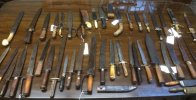-
The BladeForums.com 2024 Traditional Knife is available! Price is $250 ea (shipped within CONUS).
Order here: https://www.bladeforums.com/help/2024-traditional/
You are using an out of date browser. It may not display this or other websites correctly.
You should upgrade or use an alternative browser.
You should upgrade or use an alternative browser.
Bowie Knives of the 1800's not a "Brute de Forge" among them
- Thread starter AVigil
- Start date
- Joined
- Apr 12, 2006
- Messages
- 2,506
But, historically did blacksmiths actually leave a blade with that finish?
There should be some examples of that.
I live in the West and there is a lot of examples of what blacksmith made, during that period, at the various museums and non show any knives with that finish.
Were any of the knives locally made? I would guess not. American blacksmiths had a greater tendency to be generalized craftsmen than in Europe, where higher population and guilds led to specialization. Knives made in Europe were usually not sole authorship pieces as you see in custom knives these days. A blacksmith in the early days of America might make and repair any number of iron and steel items, but a lot of the knives would have been imported and not locally made.
Lots of factors involved in why you don't see a lot of forge finished blades left from the 1800s in the US.
- Joined
- Apr 12, 2006
- Messages
- 2,506
James,
Great post. Glad you chimed in
Thanks, Adam.
- Joined
- Feb 17, 2009
- Messages
- 7,310
Were any of the knives locally made? I would guess not. American blacksmiths had a greater tendency to be generalized craftsmen than in Europe, where higher population and guilds led to specialization. Knives made in Europe were usually not sole authorship pieces as you see in custom knives these days. A blacksmith in the early days of America might make and repair any number of iron and steel items, but a lot of the knives would have been imported and not locally made.
Lots of factors involved in why you don't see a lot of forge finished blades left from the 1800s in the US.
That is what I am thinking. While a blacksmith might leave a finish like that, the market for knives was immense back then considering every single person needed it for work, protection and just everyday living.
The great cutlers in Europe were cranking up production and flooding America with cutlery at the time. There was probably very little need for a blacksmith to make knives and compete with the imports when they had so much other profitable work to fill their days.
- Joined
- Nov 14, 2006
- Messages
- 1,109
I'd say along with the above mentioned makers, one of the influences of modern guys to use a forged finish would definitely be Jimmy Fikes.
I saw one of his knives in a early 90s magazine that blew me away...well before I got into forging at all. Still have the magazine around here somewhere.
Tad
I saw one of his knives in a early 90s magazine that blew me away...well before I got into forging at all. Still have the magazine around here somewhere.
Tad
- Joined
- Dec 8, 2011
- Messages
- 692
There was probably very little need for a blacksmith to make knives and compete with the imports when they had so much other profitable work to fill their days.
With the exception of the Civil War period, when at least in the South, there were many blades made by blacksmith's. That is why there is so many different examples seen.
Though I too, have never seen any made in what is referred to as Brut de forge, ie; no intentional scale left, nor the finger choil. Some of them are rougher than others as the smith's were pressed for time. They needed to make as many serviceable pieces as possible, as some of the confederate troops had nothing but a knife.
It would seem that there would be a few Brut de Forge examples around if they were made with any regularity.
Here are a few confederate bowies / knives. None show that feature:

jdm61
itinerant metal pounder
- Joined
- Aug 12, 2005
- Messages
- 47,357
One could certainly argue that the modern brut de forge/forge finished thing is a modern affectation which may be as hard to pull off well as a fully finished blade. As fore the old bowies, particularly the English ones, they were designed to be the best that the modern ams production process could turn out sometimes art a particular price point and other times with little regard for price. From what little I have read, you don't really see serious cutting of corners until you get into the later era of the "cowboy bowie" and its straight coat peg full tang handle.
